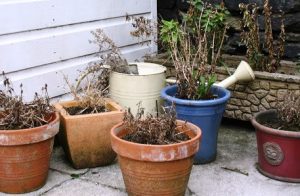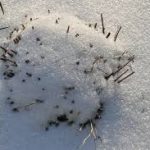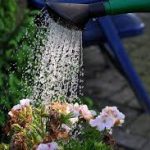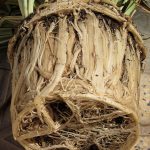by Ken Lain, the mountain gardener
If you’ve experienced failure with a flower garden, perhaps you’ve written yourself off as having a brown thumb. However, even experienced gardeners make mistakes resulting from the excitement of springtime planting and anticipation. However, when we come home with a trunk full of greenery our impatience overrules our good sense. We can’t wait to see what our gardening endeavors will produce; so we set out tender seedlings without a hardening off period, and they get scorched by the sun. Or we burn our young transplants with excessive fertilizers. Protect your investment by avoiding these common gardening mistakes.

Killer #1 Planting Too Early – It’s not fair! Winter has hung on three weeks too long, and the nurseries are tempting with all those lovely dahlias and New Guinea impatiens! If the nursery is selling these flowers, it must be time to plant, right? So you bring home a flat of colorful blossoms and set them out the first time the thermometer hits 60 degrees F.
 The problem with this approach is that the nursery was tending these tender tropicals in its greenhouse, and now you’ve slapped them into a spring mountain thaw. Plants NEVER recover from this shock to their systems.
The problem with this approach is that the nursery was tending these tender tropicals in its greenhouse, and now you’ve slapped them into a spring mountain thaw. Plants NEVER recover from this shock to their systems.
Solution: The last mountain frost is usually May 9th. Plant summer-loving flowers after this date; plant frost-loving spring flowers before this date. If the plant marker says put out two weeks after the last frost, follow this advice, weather anomalies be darned. For the earliest flowers stick to stalwarts like pansies, snapdragons, kales, and primroses.
Killer #2 Too Much (or Too Little) Water – Flowers are as particular about their moisture needs as they are about sun exposure and fertilization. Go beyond your plant’s care tag to learn about your flowers’ irrigation needs before you find them a permanent home in the garden. “Moisture-loving” may mean an inch of water per week, or it could describe a bog plant like the cardinal flower. Other flowers may fail because they’re loved to death: plants that don’t like wet feet, like lavender cotton, lavender, rosemary, and echinacea, will experience root rot with excessive watering. Too little water for thirsty varieties can bring about their prompt demise.
before you find them a permanent home in the garden. “Moisture-loving” may mean an inch of water per week, or it could describe a bog plant like the cardinal flower. Other flowers may fail because they’re loved to death: plants that don’t like wet feet, like lavender cotton, lavender, rosemary, and echinacea, will experience root rot with excessive watering. Too little water for thirsty varieties can bring about their prompt demise.
Solution: Plant together flowers that have similar needs. The landscape around your mailbox and far away from your faucet may be perfect for a xeriscape, or very low-water gardens. Install moisture-loving plants in the garden bed by the downspout.
Killer #3 Picking the Wrong Location – Some flowering plants need full sun to get enough energy to produce blooms. Without this catalyst for photosynthesis, these plants will stop blooming, weaken, and become susceptible to pests and diseases. Shade-loving flowers evolved in woodlands and on forest floors, so that excessive sun will cause scorching and brown foliage.
Solution: It’s OK to push the envelope a bit on a plant’s exposure, for example, allowing your astilbes to get an hour of morning sun, but as a general rule you should follow the exposure suggestion on the plant’s care tag.
Killer #4 Planting in the Wrong Region – If you live in Phoenix, and you order those lush lupine plants from  a New Mexico-based nursery, prepare for bleached foliage and cessation of blooming before the plants breathe their last gasps. Similarly, if your garden plot overlooks wind-swept San Fransisco Peaks, your zinnias may shiver in their pots with nary a bloom.
a New Mexico-based nursery, prepare for bleached foliage and cessation of blooming before the plants breathe their last gasps. Similarly, if your garden plot overlooks wind-swept San Fransisco Peaks, your zinnias may shiver in their pots with nary a bloom.
Solution: Visit the Flagstaff Flower Arboretum to see what grows well in your region. Shop for plants here at Watters Garden Center and ask for advice. Realize that cool weather annuals, like pansies, will peter out before the arrival of the summer solstice.
Killer #5 Root-bound Plants – Wondering how to get those root-bound specimens to loosen their grips on their nursery pots? Not by yanking on the stems! Many plants, especially non-woody herbaceous plants, are very  vulnerable at their stem levels. When you pull and tug on the stems of your new delphiniums, you’re creating injuries that provide a portal for fungi, insects, and other pests.
vulnerable at their stem levels. When you pull and tug on the stems of your new delphiniums, you’re creating injuries that provide a portal for fungi, insects, and other pests.
Solution: Never pull a plant out of the container by its foliage or its stems. Tap on the bottom of the pot to loosen the plant. If it’s slightly root bound, squeeze the pot to loosen the rootball. If it’s really root bound, get out your box cutter, and carefully slice the container away from the plant.
Free Gardening Classes ~
March 31 @ 9:30 am Advanced Container Design – The right container with the right plants can bring a space in the landscape from so-so to stunning. Lisa Lain, owner of Watters Garden Center, has been creating container designs for decades. Her 3-step program can bring floral style to your garden. The class is free to onlookers, but the first 12 students to sign up will create their own designs with Lisa’s professional guidance for a $35 fee (pots provided). Come ready to get your hands dirty and your containers beautified!
April 7 @ 9:30 am Drip Irrigation Design & Installs – April is time to get that irrigation system up and running. Learn the benefits of drip irrigation, new technologies, and how to set up a system or add a plant to it. With the right irrigation, you can save water and have healthier plants all at the same time. Don’t know how to install and run an irrigation clock? We’ll teach you! Watters’ bins of irrigation parts will be full in preparation for this class. Come early and bring a lawn chair; over 100 students attended this class the last time it was offered!
April 14 @ 9:30 am Garden Advice that Works in the Mountains – Ready to start your garden but just want a little extra help? This class will take an in-depth look at how to be successful when planting your personal garden paradise. We’ll discuss techniques for brighter, more beautiful gardens, and how to keep them healthy. Learn how to troubleshoot and combat problems like poor soil conditions, pests, and diseases that can frustrate any gardener whether a master or a novice. Bring your notepad!
Open this link to see all of Watters garden classes this spring.
Until next issue, I’ll be here at the garden center helping gardeners grow better flowers.
Ken Lain can be found throughout the week at Watters Garden Center, 1815 W. Iron Springs Rd in Prescott, or contacted through his website at WattersGardenCenter.com or FB.com/WattersGardenCenter

